|
|
Peugeot 208
|
 |
|
|
Debut: 2012
Maker: Peugeot
Predecessor:
207
|
|
|
|
| Published
on 27
Apr
2012 |
All rights reserved.
|
|
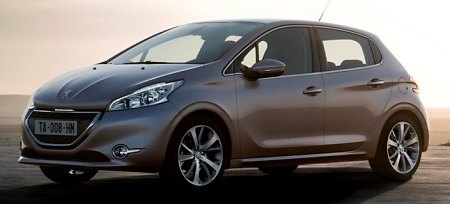
Following
5.3 million units of 205 and 7 million units of 206, Peugeot managed to
shift only 2.4 million copies of 207 worldwide. Its commercial failure
is all the more bitter as the 20X series has always been the cash cow
of the group. What led to its failure? Undoubtedly, intense competition
and the continuing availability of 206 hurt its sales, but most crucial
was the car itself – it was not good enough. Criticisms about the 207
ranged from an ugly front-end styling, dull interior, overweight to
poor interior space. In other words, poor packaging. Therefore, in the
design of 208 Peugeot put packaging on the first priority. In
particular, it focused the most energy on two areas: styling and weight
reduction.
The styling of 208 is a day-and-night difference from 207. While the
old car emphasized a harmonious form, new design chief Gilles Vidal
prefers a fashionable approach that puts more weight on elegant
details. This can be seen from the unusual C-shape taillights, the
chromed "floating" front grille, the "eyelash" LED lights above the
main headlamps and the twisted waistline below front quarter windows.
The 3-door hatchback is even more stylish, thanks to deep concaves
pressed onto the doors and a characteristic tab located at each
C-pillar – the latter obviously pays tribute to the legendary 205GTi.
Even the fog lamps have extended chromed tabs to make them different.
In short, Mr. Vidal hates ordinary and wants the 208 to speak of style
from any angles. It could be a bit heavy-handed at times, but I suppose
the 208 should have stronger showroom appeal than its key rivals, such
as Volkswagen Polo and Ford Fiesta.
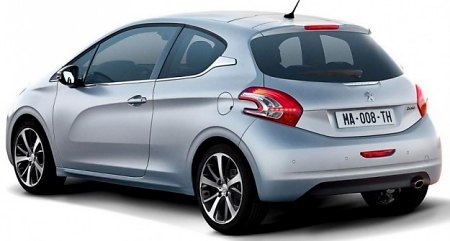
So the first target is met. The next task is to slash weight. Peugeot
did not employ many expensive lightweight materials due to the need to
control costs. Apart from the aluminum front impact beam, the rest of
the body is made of steel, including high strength and ultra-high
strength steel. Like Mazda 2, the 208 managed to cut substantial weight
by smart engineering – every component was designed and selected with
weight optimization in mind. For example, by reducing noise at source
(engine), it could cut the sound deadening materials used
throughout the cabin. By using laser welding on the roof, it can reduce
the amount of steel without compromising stiffness.
The whole car is also downsized a bit to trim weight. While it keeps
the old car's 2540 mm wheelbase, 60 mm has been chopped from the front
overhang and another 10 mm has been eliminated from the tail. The roof
now stands 10 mm closer to the ground. Brilliantly, it manages to
squeeze more space from the smaller outer dimensions. Boot volume is
increased by 15 liters, while rear passengers get 50 mm of extra
legroom. This proves how much space was wasted on its predecessor. The
new car is also more aerodynamic efficient, with a Cd starting from
only
0.29.
So how much weight has it saved? If you
compare the 208 and 207 equipped with the same 1.4HDi motor, you will
find the former is 110 kg lighter. If your comparison is based on
comparable performance, the gap will be even wider. For example, the
208 1.2VTi weighs just 975
kg, at least 150 kg lighter than the 207 with comparable performance.
In the following table you can see that model
is lighter than all key rivals bar Mazda 2. Thanks to this lightweight,
it offers the best combination of performance and emission. See the
power of lightweight engineering!
Model
|
Kerb weight
|
CO2
|
Power
|
Top speed
|
Mazda 2 1.3
|
955 kg
|
115 g/km
|
75 hp
|
104 mph
|
Peugeot 208 1.2VTi
|
975 kg
|
104 g/km
|
82 hp
|
109 mph
|
Kia Rio 1.25
|
1029 kg
|
114 g/km
|
86 hp
|
107 mph
|
Ford Fiesta 1.25
|
1041 kg
|
124 g/km
|
82 hp
|
104 mph
|
Honda Jazz 1.2 i-VTEC
|
1047 kg
|
123 g/km
|
90 hp
|
110 mph
|
Volkswagen Polo 1.2
|
1072 kg
|
119 g/km
|
70 hp
|
102 mph
|
Opel Corsa 1.2
|
1075 kg
|
119 g/km
|
86 hp
|
107 mph
|
Peugeot 207 1.4i
|
1123 kg
|
145 g/km
|
73 hp
|
104 mph
|
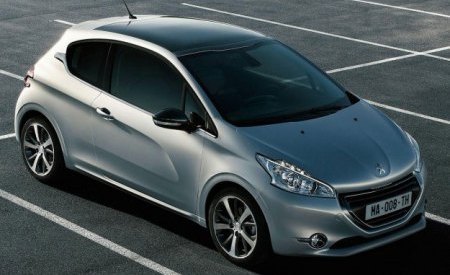
Lightweight construction also allows the 208 to take the trend of
engine downsizing. The brand-new 3-cylinder 1.2 VTi engine will play an
important role in the product mix. It has aluminum block and head and
an integrated exhaust manifold to keep weight to the minimum. Dual-VVT
guarantees good spread of torque, which peaks at 87 lbft from merely
2750 rpm. On-demand oil pump and automatic stop-start guarantee low
fuel consumption and emission. With a usable 82 horsepower, the little
motor is surprisingly capable to move the lightweight 208. Its
three-cylinder vibration is well suppressed and its vocal is pleasant
to hear. If your drive is mostly confined in urban area, the 1.2 VTi
will be the best choice.
Other choices include 1.0 VTi (68hp,
downsized version of the 1.2 VTi), 1.4 VTi (95hp), 1.6 VTi Valvetronic
(120hp), 1.6 THP DI turbo (156hp), 1.4 e-HDi (68hp) and a pair of 1.6
e-HDi (92hp or
115hp). The four-cylinder motors are carried over from the old car, so
we are not
going to
spend more time on them. To cut a long story short, the 115hp 1.6 e-HDi
is highly recommended to those spending more miles on motorway. In the
real world it is actually quicker and more refined than the 1.6 VTi.
Keen drivers should opt for the 1.6 THP, which provides near-GTi level
of performance, i.e. 0-60 under 7 seconds! The real GTi, powered by
200hp version of the same motor, will be even quicker, but it is still
a year away at least.
Peugeot must be proud that all its engines are equipped with automatic
stop-start, including the diesels – now you know why they are
called e-HDi. Equally respectable is all diesels emit no more than 99
grams of CO2 per kilometer. It takes just
one generation to go from the dirtiest to the cleanest of the class!
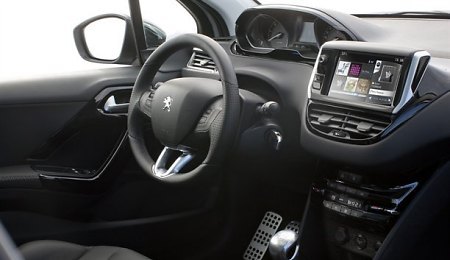
The same progress can be seen in the cabin as well. The 208
looks and feels completely different from the class norm as it has
changed
the relationship between steering wheel, instrument reading and
your sight. It employs a small-diameter steering wheel and mounts the
instrument pod high on the dashboard so that you see the instrument
reading above – rather than through – the steering wheel. What are the
benefits? Peugeot said the small steering wheel frees up space (at
least subjectively), and the high-mounted instrument keeps your sight
line closer to the road ahead thus benefit safety and ease of read.
That is generally true, but not drivers of all sizes will be benefited.
Some may find the steering wheel rim blocks the lower half of the
instrument after the driving position is adjusted to the most
comfortable position to them.
That aside, the interior is a success. Although its build quality is
not up to the high standard of Audi A1 or Volkswagen Polo, its use of
lacquer, soft-touch plastics, metallic grab handles and leather (on
premium trims) delivers a classy feel. The clean, minimalist dashboard
design is refreshing in the seas of superminis, especially compare with
the Nokia-style Fiesta dash. The use of 7-inch LCD touch screen for the
infotainment system saves dozens of buttons and is easy to use. The
cabin is also competitive in terms of space. By using thinner front
seats, the rear is finally spacious enough to seat average-size adults,
although rear headroom may be marginal if you opt for panoramic glass
roof.
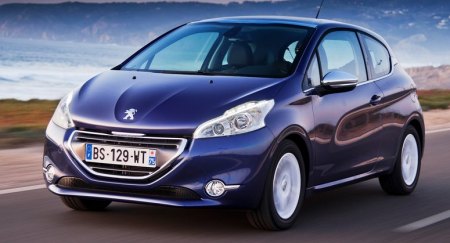
The 208's chassis is a development from the outgoing car. The layout is
nothing special – with suspension consisting of struts up front and a
twist beam at the rear, and a brushless type electric power steering –
but the tuning philosophy is different. It abandons the French
old-school
of absorbent ride for a tauter, Germanic setup. In addition to the less
weight of which its suspension needs to take care, body control is
markedly improved. It feels more nimble to steer, more stable in
corners and more precise to control. Grip level and cornering limits
are enhanced, too. However, compare with the class-leading Ford Fiesta
and VW Polo, its ride is a little stiffer and noisier. The steering is
precise but a little light and short of feedback. In addition to the
lack of 6th gear on most engines, highway refinement is not something
to be proud of.
Peugeot made no secret that it wanted to recapture the spirit of 205
with this car. Judging from its shortcomings in driving dynamics, I
would say the objective is not fully accomplished yet. However, the 208
is unquestionably more competitive than the 207, thanks to its
impressive style, packaging and efficiency. Best of all, it dares to be
different from the increasingly harmonized class norm. Perhaps this is
what Peugeot means the spirit of 205! |
Verdict:     |
Published
on 3
Apr 2013
|
All rights reserved.
|
|
208 GTI
|
|
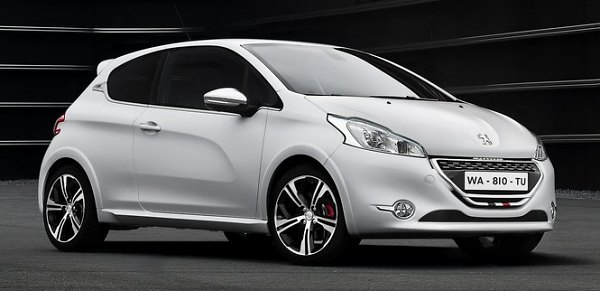
|
In recent weeks, hot hatch
lovers must be excited to see the launch of Ford Fiesta ST, Renault
Clio IV RS and Peugeot 208 GTI. All of them have the potential to be
the new class leader for the next several years. Nevertheless, after
the initial excitement is the cruel reality: they do not quite revive
the spirit of the legendary 205 GTI or the last Clio RS. In order to
please the taste of modern drivers, they are made softer, more
practical and comfortable, sacrificing the sharp edges that used to
make hot hatches so much fun to drive. Manufacturers should not be
blamed. They just chase the demand of customers. What we have to ask is
why there are so few people understand the fun of driving hot hatches.
As long as the majority of buyers think in "modern" ways, the good old
days of hot hatches will not come back.
At the launch of 208 GTI, Peugeot marketing guys talked about reviving
the spirit of 205 GTI. In certain aspects, they might be right. For
example, the new car is made slightly smaller and about 90 kg lighter
than the outgoing 207 GTI. This make it feels nimble again. Also like
the legendary ancestor, it avoids complication as far as possible. Back
in 1984, the SOHC 8-valve engine used by 205 GTI was considered as
outdated compared with Japanese multi-valve engines or Renault's
turbocharged engine being around, but it performed remarkably well in
the real world. The 208 GTI is similar. It doesn't offer any
dual-clutch geabox, torque vectoring, different driver modes or
artificial engine noise, whereas its power comes from the tried and
trusted PSA-Mini 1.6 THP. The latter gets the same state of tune as RCZ
(200 hp and 203 lbft of torque) but without the
latter's sporty exhaust. You might even say it simple to the extent of
boring!
Changes to exterior is even more subtle. Only good eyes can spot the
mesh front grille, the larger rear spoiler and the "GTi" badges at the
C-pillars. If you look for fire-breathing air intakes, jaw-dropping air
dam or racy diffusers, you will be disappointed. Even the 205/45VR17
tires are no larger than the ones on 156 hp 1.6 THP model. Inside,
there are sportier bucket seats and a metal gear knob, but pretty much
everything else are standard items.
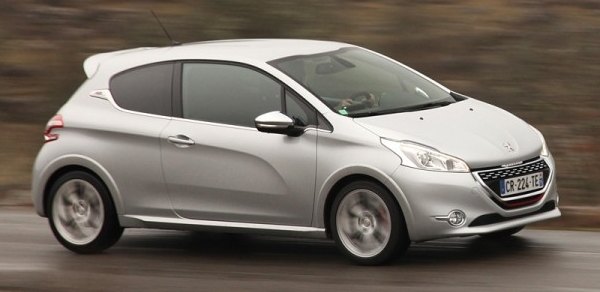
|
Modifications to the chassis is not much better. The front
subframe is strengthened to reduce distortion to steering. The
suspension is lowered by merely 8 mm, accompanied with 20 percent
stiffer springs, thicker and stiffer dampers, stronger anti-roll bars
and a slight extension of tracks (10 mm and 20 mm wider front and rear,
respectively). Reprogrammed power steering assistance and larger brakes
complete the modifications.
On the road, the 208 GTI is definitely better to drive than 207 and 206
GTI. Its chassis is more neutral and agile. Its steering gets quicker
and more precise, while the small-diameter steering wheel is handy.
However, to say it reviving the legend of 205 GTI is an overstatement.
Its handling is far more matured and forgiving at the limit than the
old car, but it is nowhere as interactive. Not only the electrical
power steering is not as feelsome, its handling is almost fool-proof,
with lots of grip so that it is not easy to overwhelm the chassis with
power, even with ESP turned off. Lift off mid-corner may tighten the
line, but just a tiny bit, so it is guaranteed not to bite you. As
novices can drive this new GTI as good as skilled drivers, there is no
room to demonstrate your superior driving skill.
On the plus side, the car is more comfortable to drive on daily basis.
Driving leisurely and you will be amazed by its similarity with lesser
208s. Its suspension rides well on bumpy roads. Its turbo engine is
quiet at low speed – probably too quiet for a performance-oriented
machine. Even at higher rev it is not especially exciting, blame to a
characterless noise. Perhaps Peugeot should have also transplanted the
exhaust from RCZ, because that car sounds much better. Noise aside,
this example of 1.6 THP engine is hampered by a soft response at low
rpm, which reads "turbo lag". As a result, its power delivery doesn't
feel as smooth and linear as the rivaling Fiesta ST and Clio RS turbo
even though they look close enough on paper. That said, if you can work
smartly on the slightly rubbery 6-speed manual gearshift to keep the
engine in its sweet zone, you can get good performance, with 143 mph
top speed and 0-60 mph in 6.5 seconds.
Now the important question: how does it compare with its rivals? The
early impression is the Fiesta ST has a better engine and a more
throttle-steerable chassis, so it comes top. The Renault and Peugeot
are very close. The former has a better engine and probably higher
performance, but its dual-clutch gearbox is annoyingly slow. The
Peugeot's gearshift is not great either, but at least it lets the
driver do the job as wished. None of them are quite the ultimate hot
hatch we having been looking for. Perhaps that is why the 205 GTI is so
memorable to us.
|
Verdict:     |
Published
on 12
Dec 2014
|
All rights reserved.
|
|
208 GTI 30th Anniversary
|
|
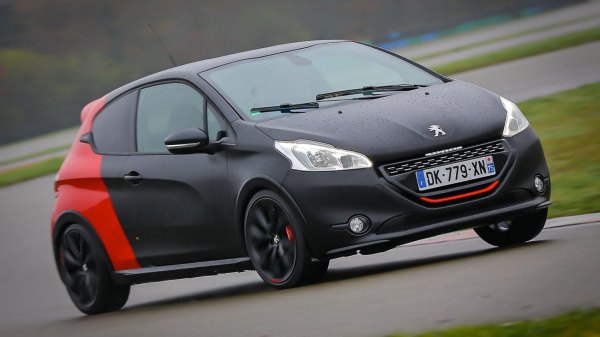
|
This year is the 30th
anniversary of Peugeot 205 GTI, which is probably the greatest hot
hatch ever made in the eyes of many car enthusiasts. In the past 3
decades, Peugeot failed to build another hot hatch as great. No matter
206 S16 (GTI), 206 RC (GTI 180), 207 GT Turbo or 207 RC (GTI), they
could not quite replicate the pure driving thrills of the original,
blame to their softer, safer chassis tuning. The latest 208 GTI came
closer, but it still leaves a thin layer between the machine and man.
You can’t help feeling sorry that it could have been tuned sharper and
more aggressive, if it was set to delight keen drivers rather than the
majority. Fortunately, Peugeot has answered our request and brought us
the GTI 30th Anniversary edition. It is set to release the full
potential of 208 GTI!
Cosmetic-wise, the 30th Anv differs very little from the regular
version. It doesn’t have an overhauled fascia like the usual practice
of rivals, nor does it get a rear diffuser like Renaultsport Clio. The
only major change is a set of larger, 18-inch wheels, yet the 205/40
tires surrounding them are no wider than the regular GTI’s. The visual
differences are so subtle that Peugeot needs to introduce a special
2-tone paint scheme to distinguish it. I am not a fan of the
combination of matt black and red as pictured, so the alternative
all-red or all-white paint might be a better option.
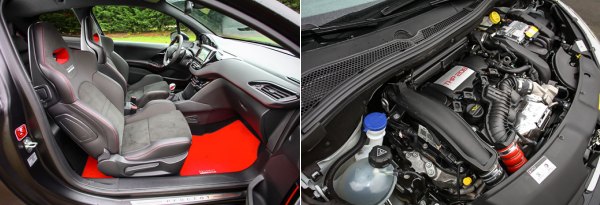
|
The special edition does get a pair of sport bucket seats
that are good-looking, grippy and supportive. Apart from the extra
performance and sharper handling, that must be a good reason to the
spend the premium of 10 percent over the GTI.
Changes to the engine are just as subtle as the exterior. The 1.6 turbo
is tuned to produce an extra 8 horsepower and 18 pound-foot of torque,
which means a total of 208 hp and 221 lbft. Considering the company’s
RCZ R is good for 270 hp and 243 lbft from largely the same motor, this
state of tune is quite modest. However, the hot hatch’s 6-speed manual
gearbox does get the same gear ratios as the RCZ R, as is the
standard-fitted Torsen limited slip differential, which enhances
traction significantly. Meanwhile, more grip is guaranteed by the
Michelin Pilot Super Sport rubbers it employ. Compared to the regular
GTI, its suspension is set 10 mm closer to the ground. Front and rear
springs are stiffened by 30 and 80 percent respectively. Front and rear
tracks are widened by 22 mm and 16 mm. Stoppers are also upgraded. The
front brakes get not only larger discs but also Brembo 4-pot calipers.
On the road, the extra power is not easy to be detected without
comparing with the regular GTI side by side. However, with less than
1200 kg to haul, 200-plus horsepower and pound-foot are more than
enough to feel quick – we are talking about 0-60 mph in the low
6-seconds range. I doubt more power could bring more fun. The
BMW-designed engine is smooth and flexible. The gear ratios are well
spaced, although the long-throw shifter is not the most enjoyable to
use.
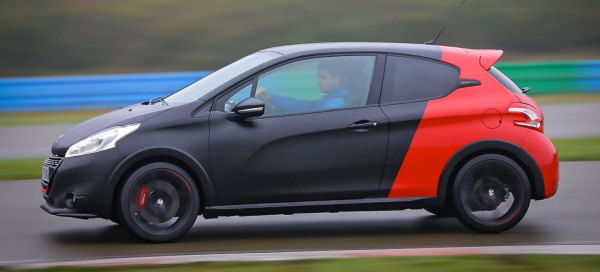
|
What makes the difference is how much better the 30th Anv
edition put down the power. The combination of new rubbers and LSD
eliminates wheel spin in tight corners, allowing you to plant the
throttle earlier and deeper out of bend, thus corners considerably
faster. Like the regular GTI, there is some torque steer can be felt,
but it rarely affects the maneuver or spoils the driving pleasure. With
stiffer suspensions, the car controls its pitch and roll more tightly,
feels sharper and more precise to turn. The steering feels slightly
heavier and more communicative than on the GTI. The braking is vastly
improved, offering stronger stopping power and great pedal feel. In
addition to the enhanced traction, this gives you a lot more confidence
to push the car harder in the twisty.
The car is also more playful. Its understeer has been dialed back
thanks to the use of a softer anti-roll bar up front and a stiffer one
at the back. Moreover, Peugeot remapped its traction and stability
control to allow more slip before intervening. Even if you switch off
the electronics completely, you will find a well balanced chassis and a
much more neutral attitude which allows you to kick the tail out with a
sudden lift of throttle, something never seen on a Peugeot since 205
GTI! Among the current generation of hot hatches, only Ford Fiesta ST
is more playful still.
Thankfully, the GTI 30th Anniversary edition is still a great road car
to drive every day. Its ride remains composed if firm. The cabin
remains stylish and premium feeling. Exhaust and tire noises are not
excessive. Fuel consumption is as good as economy cars of a decade ago.
Peugeot is finally back to the top of the game!
|
Verdict:      |
|
|
|
|
|
|
|
|
|
|
208 1.2VTi
|
2012
|
| Front-engined,
FWD |
| Steel monocoque |
| Mainly steel |
| 3962 / 1739 / 1460 mm |
| 2538 mm |
Inline-3
|
| 1199 cc |
DOHC 12 valves, DVVT
|
| - |
| - |
| 82 hp |
| 87 lbft |
| 5-speed manual |
F: strut
R: torsion-beam
|
| - |
| 185/65TR15 |
975 kg
|
| 109 mph (c) |
11.5 (est)
|
| - |
|
208
1.6VTi
|
2012
|
| Front-engined,
FWD |
| Steel monocoque |
| Mainly steel |
| 3962 / 1739 / 1460 mm |
| 2538 mm |
Inline-4
|
| 1598 cc |
DOHC 16 valves, VVT, VVL
|
| - |
| - |
| 120 hp |
| 118 lbft |
| 5-speed manual |
F: strut
R: torsion-beam
|
| - |
| 195/55HR16 |
1090 kg
|
| 118 mph (c) |
8.4 (c)
|
| - |
|
208 1.6HDi
|
2012
(2015)
|
| Front-engined,
FWD |
| Steel monocoque |
| Mainly steel |
| 3962 / 1739 / 1460 mm |
| 2538 mm |
Inline-4, diesel
|
| 1560 cc |
DOHC 16 valves
|
VTG turbo
|
| CDI |
115 hp (120 hp)
|
199 lbft (210 lbft)
|
| 6-speed manual |
F: strut
R: torsion-beam
|
| - |
| 195/55HR16 |
1090 kg (1115 kg)
|
| 118 mph (c) |
9.1 (c) (8.8)
|
| - |
|
|
|
|
|
Performance
tested by: -
|
|
|
|
|
|
|
208 1.6THP
|
2012
(2015)
|
| Front-engined,
FWD |
| Steel monocoque |
| Mainly steel |
| 3962 / 1739 / 1460 mm |
| 2538 mm |
Inline-4
|
| 1598 cc |
DOHC 16 valves, VVT
|
| Turbo |
| DI |
156 hp (165 hp)
|
177 lbft
|
| 6-speed manual |
F: strut
R: torsion-beam
|
| - |
| 205/45VR17 |
1140 kg
|
134 mph (c) (135 mph)
|
6.9 (c) (7.0)
|
| - |
|
208 GTI
|
2013
(2015)
|
| Front-engined,
FWD |
| Steel monocoque |
| Mainly steel |
| 3962 / 1739 / 1460 mm |
| 2538 mm |
Inline-4
|
| 1598 cc |
DOHC 16 valves, DVVT, VVL
|
| Turbo |
| DI |
200 hp (208 hp)
|
203 lbft (221 lbft)
|
| 6-speed manual |
F: strut
R: torsion-beam
|
| - |
| 205/45VR17 |
1160 kg
|
| 143 mph (c) |
6.5 (c) (6.2)
|
| - |
|
208 GTI 30th Anv
(GTI by Peugeot Sport)
|
2014
(2015)
|
| Front-engined,
FWD |
| Steel monocoque |
| Mainly steel |
| 3962 / 1739 / 1450 mm |
| 2538 mm |
Inline-4
|
| 1598 cc |
DOHC 16 valves, DVVT, VVL
|
| Turbo |
| DI |
208 hp / 5800 rpm
|
221 lbft / 1700 rpm
|
| 6-speed manual |
F: strut
R: torsion-beam
|
| - |
| 205/40ZR18 |
1185 kg
|
| 143 mph (c) |
6.2 (c) / 6.5*
|
| 16.1* |
|
|
|
|
|
| Performance
tested by: *Autocar |
|
|
|
|
|
|
208 1.2THP
|
2015
|
| Front-engined,
FWD |
| Steel monocoque |
| Mainly steel |
| 3962 / 1739 / 1460 mm |
| 2538 mm |
Inline-3
|
| 1199 cc |
DOHC 12 valves, DVVT
|
| Turbo |
| DI |
| 110 hp |
| 151 lbft |
| 5-speed manual |
F: strut
R: torsion-beam
|
| - |
| 185/65R15 |
1060 kg
|
| 118 mph (c) |
9.0 (c)
|
| - |
|
|
|
|
|
|
|
| Performance
tested by: - |
|
|
|
|
|
|
|
|
Copyright©
1997-2014
by Mark Wan @ AutoZine
|
|